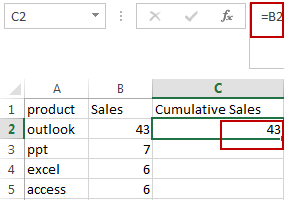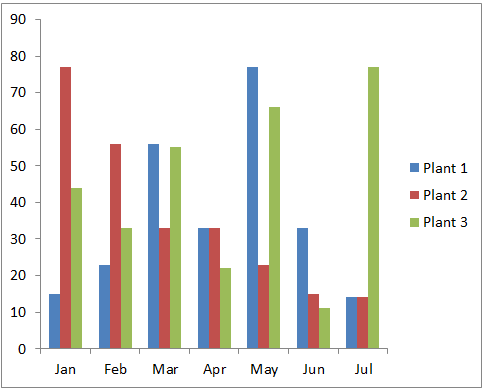
- #CREATE PARETO CHART IN EXCEL 2013 HOW TO#
- #CREATE PARETO CHART IN EXCEL 2013 UPDATE#
- #CREATE PARETO CHART IN EXCEL 2013 SERIES#
The principle states that about 80% of the effects come from 20% of the causes. From him derives a famous principle from which the relative Pareto analysis derives. Vilfredo Pareto was an Italian economist.
#CREATE PARETO CHART IN EXCEL 2013 HOW TO#
In this article, I will show you how to make a Pareto chart in Excel.Ī Pareto chart is a kind of chart that includes both bars and a line graph, with the bars representing individual values in descending order and the line representing the cumulative total.
How to Add a Secondary Axis in Excel Charts.How to create a Pareto chart in Excel? Do you want to know the major causes on which you should devote your efforts? Here is the reason why you should read this article. Analyzing Restaurant Complaints using Pareto Chart. Related Project Management and Charting Tutorials: Do leave your footprints in the comments section 🙂 
I would love to hear your thoughts on this technique and how you have used it.
#CREATE PARETO CHART IN EXCEL 2013 UPDATE#
Now, when you change the target using the scroll bar, the Pareto chart would update accordingly. You have created an interactive Pareto Chart in Excel.
Right-click on any of the highlighted bars and change the color to Red. Cumulative %: Line (also check the Secondary Axis check-box). In the Change Chart Type dialogue box, select Combo in the left pane and make the following changes:. #CREATE PARETO CHART IN EXCEL 2013 SERIES#
This will insert column chart with 3 series of data (cumulative percentage, the bars to be highlighted to meet the target, and remaining all other bars) =IF($B$13 Charts –> 2-D Column –> Clustered Column.
In cell E2 enter the following formula (and drag or copy for all cell – E2:E10):. In cell D2, enter the following formula (and drag or copy for all cell – D2:D10):. For example, if you have the target value as 70%, it would return 77%, indicating that you should try and resolve the first three issues. This formula returns the cumulative value that would cover the target value. In cell B13, enter the following combination of INDEX, MATCH, and IFERROR functions:. Since you cannot specify a percentage value to a scroll bar, we simply divide the scroll bar value (in B14) with 100 to get the percentage value. In cell B12, I have used the formula =B14/100. In cell B14, I have the target value that is linked to the scroll bar (whose value varies from 0 to 100). Here are the steps to make this interactive Pareto chart in Excel: The red one is highlighted when the cumulative percentage value is close to the target value. 
The idea here is to have 2 different bars. In this case, a user can specify the % of complaints that need to be tackled (using the excel scroll bar), and the chart will automatically highlight the issues that should be looked into. Now that we have a static/simple Pareto chart in Excel, let’s take it a step further and make it a bit interactive. Creating a Dynamic (Interactive) Pareto Chart in Excel For example, targeting the first 3 issues would automatically take care of ~80% of the complaints.įor example, targeting the first 3 issues would automatically take care of ~80% of the complaints. This Pareto chart highlights the major issues that the hotel should focus on to sort the maximum number of complaints. How to Interpret this Pareto Chart in Excel Adjust the Vertical Axis values and the Chart Title.
Cumulative %: Line (also check the Secondary Axis check box). In the Change Chart Type dialogue box, select Combo in the left pane.  Right-click on any of the bars and select Change Series Chart Type. This inserts a column chart with 2 series of data (# of complaints and the cumulative percentage). Select the entire data set (A1:C10), go to Insert –> Charts –> 2-D Column –> Clustered Column.
Right-click on any of the bars and select Change Series Chart Type. This inserts a column chart with 2 series of data (# of complaints and the cumulative percentage). Select the entire data set (A1:C10), go to Insert –> Charts –> 2-D Column –> Clustered Column. 
Here are the steps to create a Pareto chart in Excel: NOTE: To make a Pareto chart in Excel, you need to have the data arranged in descending order.ĭownload the Excel Pareto Chart Template Creating a Simple (Static) Pareto Chart in Excel Let us take an example of a Hotel for which the complaints data could look something as shown below:
Dynamic (Interactive) Pareto Chart in Excel.Ĭreating a Pareto Chart in Excel is very easy.Īll the trickery is hidden in how you arrange the data in the backend. In this tutorial, I will show you how to make a: This is a widely used concept in project management to prioritize work. The 80/20 percentage value may vary, but the idea is that of all the issues/efforts, there a few that result in maximum impact. Pareto Chart is based on the Pareto principle (also known as the 80/20 rule), which is a well-known concept in project management.Īccording to this principle, ~80% of the problems can be attributed to about ~20% of the issues (or ~80% of your results could be a direct outcome of ~20% of your efforts, and so on.). Watch Video – How to Make a Pareto Chart in Excel








 0 kommentar(er)
0 kommentar(er)
